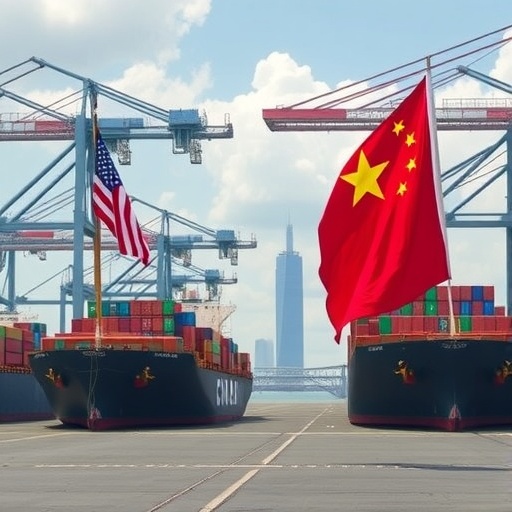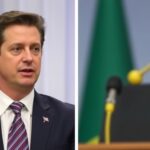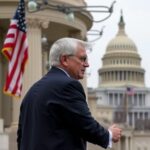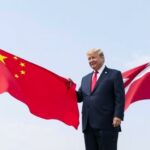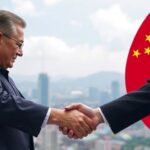US Launches Tariff Probe into China’s Phase One Trade Agreement Compliance Amid Escalating Tensions
In a bold move signaling renewed economic confrontation, the Trump administration has initiated a sweeping tariff probe into China’s compliance with the 2020 Phase One trade agreement, accusing Beijing of falling short on critical commitments while export controls intensify on both sides. This investigation, announced on Monday, could reignite the US-China trade war that defined much of President Trump’s first term, potentially leading to new tariffs on billions of dollars in Chinese goods.
The probe stems from longstanding frustrations within the Trump administration over China’s purchase targets, intellectual property protections, and agricultural commitments outlined in the deal signed on January 15, 2020. U.S. Trade Representative Katherine Tai stated in a press release, “China’s repeated failure to honor the Phase One agreement undermines fair trade and American workers. This investigation will ensure accountability.” As global supply chains remain fragile post-pandemic, this development arrives at a pivotal moment, with implications rippling through industries from semiconductors to soybeans.
Officials cited data showing China met only about 58% of its $200 billion purchase commitment by the end of 2021, according to Peterson Institute for International Economics estimates. The shortfall, exacerbated by the COVID-19 pandemic, has fueled accusations of deliberate non-compliance. Meanwhile, recent escalations in export controls—including U.S. restrictions on advanced chip technology to China and Beijing’s retaliatory bans on rare earth exports—have heightened the stakes, prompting fears of a full-blown decoupling in critical tech sectors.
Trump’s Aggressive Stance Revives Phase One Scrutiny
President Donald Trump’s return to the White House has quickly refocused U.S. policy on confronting China’s economic practices, with the new tariff probe marking an early and assertive step. During his campaign, Trump repeatedly vowed to impose even steeper tariffs if reelected, framing the Phase One deal as a temporary truce rather than a lasting solution. “China has been ripping us off for decades,” Trump declared in a recent rally speech in Ohio, echoing sentiments from his 2016-2020 tenure when tariffs on $360 billion of Chinese imports were enacted.
The Trump administration‘s probe, conducted under Section 301 of the Trade Act of 1974, will examine not just purchase shortfalls but also broader issues like forced technology transfers and currency manipulation—allegations that were central to the original trade war. Sources familiar with the matter indicate the investigation could span six to twelve months, involving public hearings and input from affected industries. This mirrors the 2018 probe that led to the initial tariffs, but with added urgency due to advancements in China’s domestic tech capabilities.
Economists note that the Phase One agreement was hailed as a diplomatic win at the time, averting further escalation after two years of negotiations. It required China to boost purchases of U.S. goods by $200 billion over two years in categories like energy, manufacturing, and agriculture. However, compliance reports from the U.S. Trade Representative’s office have been damning: In 2020, China achieved only 83% of targeted purchases, dropping to 33% in 2021 amid global disruptions. By 2022, the figure hovered around 40%, per official data, leaving a $100 billion-plus gap that American farmers and manufacturers say has cost jobs and revenue.
China’s Shortfalls: From Soybeans to Semiconductors
At the heart of the tariff probe are China’s unmet obligations under the Phase One trade agreement, particularly in agriculture and energy sectors where U.S. exporters were promised market access. American soybean farmers, for instance, were hit hardest; China committed to buying an additional $12.5 billion in U.S. agricultural products annually, but actual purchases fell short by over 20% in key years. The American Farm Bureau Federation reported that while exports rebounded somewhat post-deal, retaliatory tariffs from earlier in the trade war still linger, costing the sector $27 billion since 2018.
Beyond agriculture, the probe targets intellectual property (IP) enforcement, a cornerstone of the agreement. China pledged structural reforms, including stronger patent protections and crackdowns on cyber theft, but U.S. officials allege persistent violations. A 2023 report by the U.S. International Trade Commission highlighted that IP theft from China costs American firms up to $600 billion annually, with little evidence of the promised reforms taking root. In the tech realm, commitments to avoid forcing U.S. companies to transfer technology remain unfulfilled, as evidenced by ongoing disputes involving firms like Apple and Qualcomm operating in China.
Energy commitments also falter: China was to import $52.4 billion in U.S. liquefied natural gas (LNG) and crude oil over 2020-2021, but deliveries reached only 64% of the target, according to the U.S. Energy Information Administration. This shortfall has squeezed American producers, who ramped up output expecting stable demand. As one Texas oil executive told Reuters anonymously, “We invested billions based on that deal, and now we’re left holding the bag while China sources from Russia instead.” These gaps illustrate a pattern of selective compliance, where Beijing prioritizes its strategic interests over treaty obligations.
Export Controls Fuel the Fire in US-China Trade Friction
The tariff probe unfolds against a backdrop of intensifying export controls, which have transformed the US-China rivalry into a high-tech arms race. In October 2023, the Biden administration—whose policies the incoming Trump administration vows to build upon—expanded restrictions on semiconductor exports to China, targeting firms like Nvidia and AMD to curb Beijing’s AI and military advancements. China retaliated swiftly, imposing controls on gallium and germanium exports, critical minerals used in chip manufacturing, which account for 98% of global supply from China.
These measures have disrupted supply chains worldwide. The Semiconductor Industry Association estimates that U.S. export controls could shave 1-2% off China’s GDP growth by 2025, while prompting Beijing to accelerate its “Made in China 2025” initiative. Trump officials have signaled even tougher stances, with nominee for Commerce Secretary Howard Lutnick hinting at “decoupling on steroids” in a CNBC interview. “We’re not just talking tariffs; we’re talking full-spectrum economic security,” Lutnick said.
Broader implications include rising costs for consumers: A study by the National Bureau of Economic Research found that previous export controls increased U.S. chip prices by 5-10%. In China, state media like Xinhua has decried the probe as “economic bullying,” vowing countermeasures that could include further restrictions on U.S. firms’ access to its market. This tit-for-tat escalation risks fragmenting global trade, with allies like the EU watching closely—Germany, for example, exported €100 billion in goods to China in 2023, per Eurostat, and fears collateral damage.
Industry Voices and Economic Ripples from the Probe
Stakeholders across sectors are bracing for the probe’s fallout, with U.S. manufacturers divided on its merits. The U.S. Chamber of Commerce warned in a statement that new tariffs could add $1,000 to the average American household’s annual expenses, citing inflationary pressures from the original trade war. Yet, groups like the Steel Manufacturers Association applaud the move, arguing it levels the playing field against subsidized Chinese imports that flooded markets with cheap steel, undercutting U.S. production by 30% since 2018, according to industry data.
Agricultural lobbies, still smarting from Phase One shortfalls, are pushing for swift action. National Corn Growers Association President Tom Hammer told Bloomberg, “China’s promises were empty calories for our farmers. This probe is a chance to enforce real change.” On the flip side, tech giants like Intel have lobbied for calibrated export controls, fearing overreach could stifle innovation. Intel’s CEO Pat Gelsinger testified before Congress last year that while national security matters, blanket restrictions might cede ground to competitors in Taiwan and South Korea.
Globally, the probe could shift trade flows: Vietnam and Mexico have seen a 50% surge in U.S. imports since 2018 as companies diversify from China, per U.S. Census Bureau figures. However, this “China-plus-one” strategy isn’t foolproof; a World Bank report projects that renewed tariffs might slow global GDP growth by 0.5% in 2025, hitting emerging markets hardest.
Financial markets reacted swiftly to the announcement, with the Dow Jones dropping 150 points on Monday and Chinese stocks in Hong Kong falling 2%. Analysts at Goldman Sachs predict volatility ahead, with potential for a 10-15% tariff hike on $100 billion of goods if non-compliance is confirmed.
Path Forward: Negotiations, Tariffs, or Total Decoupling?
As the tariff probe gains momentum, the Trump administration faces a crossroads in US-China relations: revive negotiations, impose punishing tariffs, or pursue deeper decoupling. White House advisors suggest a mix, starting with bilateral talks in early 2025 to address Phase One lapses, potentially under a revised framework that includes WTO involvement. U.S. Ambassador to the WTO Matthew Goodman indicated in a Foreign Policy op-ed that “multilateral pressure could compel China to act where unilateral threats have fallen short.”
Yet, Beijing’s response remains defiant. Chinese Foreign Ministry spokesperson Wang Wenbin stated, “The U.S. should reflect on its own protectionism rather than scapegoating China.” If talks stall, new tariffs could target high-value sectors like electric vehicles and renewables, where China dominates 80% of solar panel production, per the International Energy Agency. This might accelerate U.S. reshoring efforts, bolstered by the CHIPS Act’s $52 billion in subsidies, but at the cost of short-term disruptions.
Long-term, experts foresee a bifurcated global economy: one aligned with U.S. standards, another with China’s. The Carnegie Endowment for International Peace warns this could exacerbate geopolitical tensions, from the South China Sea to Taiwan. For American consumers and businesses, the probe promises accountability but risks higher prices and uncertainty. As Trump prepares his economic agenda, the world watches whether this trade agreement enforcement will bridge divides or widen the chasm in the world’s most vital bilateral relationship.


